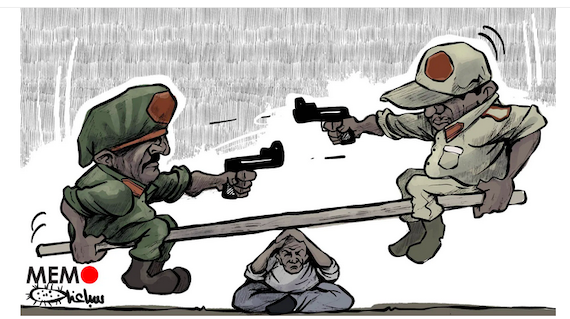What usually happens in the never-ending alternating between civilian and military rule is simple: people would demonstrate against the government of the day for whatever reasons, hundreds get killed and injured by the army, before another government comes in. A few years later, the same cycle is repeated, when another general would step in and take over.
Indeed the Sudanese Army, like many others in the region, has been the backbone of the country since independence in 1956, when the Republic of Sudan was first formed and led by a civilian government headed by Ismail Al-Azhari. Two years later, his successor, Abdallah Khalil, was deposed in a military coup led by General Ibrahim Abboud. In May 1969, Colonel Gaafar Muhammad Al-Numaryi led another successful coup, forming a military government that would last until he was toppled in a civilian uprising in April 1985.
Power struggle in Sudan, between Genersl Abdel Fattah Abdelrahman al-Burhan and his Deputy Mohamed Hamdan Dagalo – Cartoon [Sabaaneh/Middle East Monitor]
Fearing violence and further deterioration in the country, another General stepped in and took over, promising democratic rule within a year. General Muhammad Hasan Siwar Dhahab handed over power to an elected civilian coalition. Another coup was in the making and Omar Al-Bashir came to power, to stay as head of state until massive civilian demonstration ended his rule in 2019 and, again, the Army took over, leading the country to where it is today.
All previous governments, either military juntas or civilian administrations, have promised elections and return to elected government. They usually deliver on such promises; at some point, elected civilians indulge in bickering and quarrels giving another general the excuse to take over. However, this time we have two generals instead of one: Mohamed Hamdan Dagalo, known as Hemedti, and General Abdel Fattah Al-Burhan, Commander of the Sudanese Army.
During these rather tenacious coups and counter-coups, full and effective transition to democratically elected government, decided by the ballots not bullets, fails. More people are killed and injured by the same Armed Forces that always claim they took over only to protect civilians and keep the country united.
In reality, all Sudan’s major problems have either been started by the Army or took place under its watch. As early as the 1960s, the generals seemed to be making things worse every time they intervened, claiming to help the nation make that elusive turn to multiparty democracy. Political parties and publicly recognised politicians have always been part of the Sudanese political tradition. Many prominent political parties have been around long before independence, enjoying great public credentials too. But, once in power, things go wrong and the generals are ready again.
Once in power, the Army somehow becomes the problem and the creator of more problems. Even the secession of South Sudan into an independent country in 2011 happened because the generals failed to solve what started as a political issue.
When the late Colonel John Garang picked up arms against the Khartoum government in the early 1980s, he was not demanding full independence for South Sudan. His original idea was power sharing, more self-rule for the south and, above all, democratic political process within a united and stable Sudan. When all that failed and the civil war became more protracted, encouraging more foreign powers’ meddling, South Sudan independence became inevitable. Today, there are two failing “Sudans”, instead of one.
The Sudanese Armed Forces never publicly rejected democracy. In fact they, historically, always lent support to the idea in some form. Once in power, they would do everything, under all sorts of excuses, to derail the process at some point. Such history makes the democratic transition, under General Siwar Dhahab in 1986, a unique experience in the Army’s long history of power grabbing.
The power struggle that broke out on 15 April appears to be different to all previous similar situations in which the Army, ultimately, prevails – not necessarily for the good of the country, though. General Hemedti, is also claiming to lead a parallel “official” army, known as the Rapid Response Forces. His help was essential for the removal of his former boss, Al-Bashir, giving him some credit to claim some kind of legitimacy in being “for the people”, something his counterpart Gen Abdel Fattah Al-Burhan, wants to deny him.
The irony here is that, deep down, both men never really believed in the idea of transition to democracy in which the all “armies”, both “official” and otherwise, have no role other than what the constitution provides for them. But generals, in this part of the world – including Sudan – hate constitutions because such documents usually strip them of any legitimacy to claim power.
This makes any talk of a negotiated settlement between the two men as hopeless. Generals usually settle their disagreements on the battlefield, on piles of civilian corpses and mountains of destruction.
While the United States brokered truce appears to be partially holding on its second day, it should not be taken for granted that it will become a permanent ceasefire, as many hope. Even if that happens, it is unlikely to lead to any political process that might end in return to a civilian rule through elections, any time soon.
In a way, Hemedti and Al-Burhan will continue to fight for the “I am Sudan” motto, rather than for democracy and Sudan’s future. Each one of them believes he has the right to decide when and how any democratic transition should happen when, in fact, both are only repeating the vicious cycle of military rule and its disastrous consequences.
The views expressed in this article belong to the author and do not necessarily reflect the editorial policy of Middle East Monitor or Informed Comment.
 This work by Middle East Monitor is licensed under a Creative Commons Attribution-NonCommercial-ShareAlike 4.0 International License.
This work by Middle East Monitor is licensed under a Creative Commons Attribution-NonCommercial-ShareAlike 4.0 International License.



 © 2025 All Rights Reserved
© 2025 All Rights Reserved